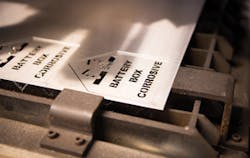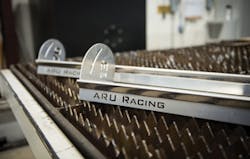Improving laser cutting with fiber choice
By Michelle Avilla
More Industrial Laser Solutions Articles |
A high-power diode laser primer Improving laser cutting with fiber choice The hole story: Femtosecond manufacturing improves automobile fuel efficiency |
Normally, one doesn’t think to combine food processing and oil and gas into one sentence. But a trip to Houston’s Sani-Weld quickly changes that. There you’ll find a company that fabricates items for both those industries and others.
Sani-Weld’s claim to fame lies in its creative solutions for industries requiring sanitary equipment and a pristine manufacturing environment, making Sani-Weld a natural partner for the food processing industry since the smallest problem can wreck havoc with the nation’s food supply. However, food processing is just one of many industries requiring a precise and methodological manufacturing process. Industries such as oil and gas, medical, pharmaceutical, and semiconductor industries also rely on Sani-Weld and its custom fabrication solutions.
Services
The breadth of industries served by this company means it works with a wide range of different metals; stainless steel, aluminum, and brass are used regularly. Before the company can start assembling its creations, though, it needs to cut them.
Sani-Weld has long done that cutting with plasma, routinely using two 1990s era units from Hypertherm in house and another out in the field. While these systems do a good job and have served the company well, Sani-Weld also had a need to cut some of its material with laser.
Despite being 35 years old, the company had actually never owned a laser cutting system. It relied instead on outsourcing to get those parts cut. This arrangement worked well when the business was smaller; however, as the business grew, so too did the issues associated with outsourcing.
The first problem is cost, where the company estimates it spent nearly $200,000 on outsourcing last year alone. The second problem is turn-around time, which averaged about a week, causing a delay in both delivery to the customer and bottlenecks inside the facility.
Sani-Weld started looking at options and discovered something promising at the FABTECH show two years ago, where it was impressed by a fiber laser system being shown by AKS Cutting Systems, a company that had just unveiled its AccuKut System with a Hypertherm HyIntensity fiber laser.
Fiber laser benefits
Although Sani-Weld had always outsourced its product to a service center using a CO2 laser, it was intrigued by the fiber laser system for a number of reasons. First, the company liked the fact that the fiber laser could cut a wide range of different materials, including the polished stainless steel, mild steel, and aluminum often used in the food industry. In addition, Sani-Weld was impressed with the speed and cut quality delivered by the fiber laser system. Another fiber laser attribute was its price. Fiber lasers offer the speed and cut quality of more traditional CO2 lasers, but cost much less. Capital cost is lower, as are operating costs. Higher wall-plug efficiency is one reason why.
Tate Picard, who leads Hypertherm’s fiber laser team, explains it this way, "For every unit of power that passes through a CO2 cutting system, only 8 to 10 percent is actually used. With fiber laser, power efficiency averages 31 percent, making it 86 percent more efficient."
The associated "chiller" used by all laser systems is also smaller and less expensive, further driving down utility bills. Additionally, fiber laser beams are delivered via a cable and do not rely on mirrors to move the light beam. Moreover, a fiber laser is much more forgiving to the cutting table it is placed on. It is entirely possible to install a fiber laser system onto an existing plasma cutting table, provided the table has good motion capabilities.
The lack of mirrors and turbines means fiber lasers require little to no maintenance. This is in contrast to traditional gas lasers, which require regular maintenance. Mirrors need to be maintained and calibrated; resonators and turbines that move the gas need to be replaced; and the lasing gas needs to be cleaned out regularly because of its tendency to collect impurities. All of this maintenance adds up. One CO2 system, for example, can cost $40,000 per year to maintain.
Doug Manchester, Sani-Weld’s president, says, "We were intrigued by fiber laser from the get-go. The more we learned about the technology, the more we became convinced it was the perfect solution for us."
Installation and results
The company worked with AKS to install the fiber laser in its Houston facility. Fiber laser systems come in a range of different power levels. For example, Hypertherm offers 1, 1.5, 2, and 3 kW systems. Sani-Weld decided to go with the 2 kW system, and so far is very happy with its choice.
"Job output with the new system is through the roof," continues Manchester. "In the past, it took us a week to turn product around; now we can do it in less than a day."
For Sani-Weld, though, the faster turn-around is just the beginning. The AKS system is an integrated cutting solution that incorporates Hypertherm Built for Business products.
The CNC, torch height control, and CAM software controlling the system were developed to work together. This tight integration means better control of all the cutting parameters and a better finished product.
Dross is non-existent so a post-cutting step is eliminated. Holes, fine feature cutting, and marking are now possible, and the company is able to cut an even broader range of material, including nickel-cobalt, a material it has long wanted to cut, but could not.
Today, Sani-Weld can take on nearly any job that comes through the door. It has not only managed to reduce the amount of money spent on outsourcing, but is also getting product into the hands of customers seven times faster -- not bad for a day’s work.
Michelle Avilla([email protected]) is the public relations manager at Hypertherm (www.hypertherm.com), Lebanon, NH.
More Industrial Laser Solutions Current Issue Articles
More Industrial Laser Solutions Archives Issue Articles


